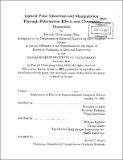Optical pulse distortion and manipulation through polarization effects and chromatic dispersion
Author(s)
Chou, Patrick Chien-pang, 1970-
DownloadFull printable version (6.646Mb)
Other Contributors
Massachusetts Institute of Technology. Dept. of Electrical Engineering and Computer Science.
Advisor
Hermann A. Haus and William Kelleher.
Terms of use
Metadata
Show full item recordAbstract
Pulse distortion and shaping mechanisms play a significant role in optical fiber communication and sensing. In this thesis we shall investigate techniques which alleviate pulse deterioration due to polarization effects, and utilize large chromatic dispersion for system performance enhancement. We first demonstrate a method of mitigating polarization mode dispersion (PMD) in fiber optic communication systems. PMD has been a known effect for over a decade. However, it was not an impediment to system performance until recent advances in communication system bit rates. Today, with 10 Gb/s and 40 Gb/s channel rates appearing in new system equipment, PMD prohibits the use of many fiber cables already installed. Current PMD compensation techniques that require feedback control have difficulty meeting the speed and reliability requirements of telecom standards. In the first part of this thesis we investigate alternative compensation schemes which reduce the complexity of the feedback schemes. We next exploit the recent availability of ultra-long length chirped fiber Bragg gratings (FBG). Their enormous chromatic dispersion enables methods of improving current techniques in sensing and high speed optical sampling. In one experiment, we modulate the frequency of a standard distributed Bragg reflector (DBR) laser, and then apply the dispersion of the ultra-long FBG. Picosecond pulses are formed, whose repetition rate is independent of the laser cavity length. Since the gain of the laser is not modulated, the timing jitter is fundamentally limited only by the frequency noise of the laser. Finally, we again utilize the large delay of an ultra-long chirped FBG to implement arbitrary dynamic optical filtering of pulse spectra. In sensing applications such as fiber gyroscopes and optical coherence tomography (OCT), a wide Gaussian spectrum is ideal for low error in the gyro, and high image resolution in OCT. A modelocked fiber laser provides very wide spectra, but the shape can be irregular. We stretch the modelocked pulse temporally with an FBG, and access the frequency components in the time domain. We can then selectively suppress frequencies with an amplitude modulator to synthesize a Gaussian spectrum. Polarization effects and chromatic dispersion will inevitably appear in many optical systems. It is the goal of this thesis to show that their effects can be minimized or utilized for system performance enhancement.
Description
Thesis (Ph.D.)--Massachusetts Institute of Technology, Dept. of Electrical Engineering and Computer Science, 2001. Includes bibliographical references (leaves 112-129).
Date issued
2001Department
Massachusetts Institute of Technology. Department of Electrical Engineering and Computer SciencePublisher
Massachusetts Institute of Technology
Keywords
Electrical Engineering and Computer Science.